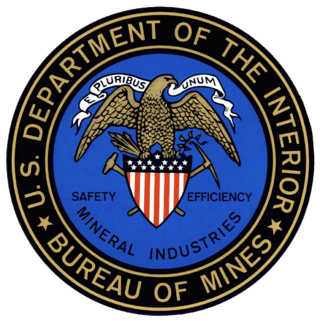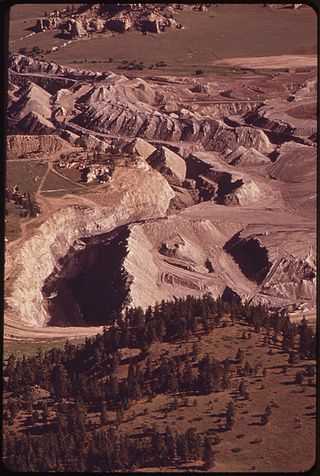
A gravel pit is an open-pit mine for the extraction of gravel.

Mining in the engineering discipline is the extraction of minerals from the ground. Mining engineering is associated with many other disciplines, such as mineral processing, exploration, excavation, geology, metallurgy, geotechnical engineering and surveying. A mining engineer may manage any phase of mining operations, from exploration and discovery of the mineral resources, through feasibility study, mine design, development of plans, production and operations to mine closure.

Mine reclamation is the process of modifying land that has been mined to ecologically functional or economically usable state. Although the process of mine reclamation occurs once mining is completed, the planning of mine reclamation activities occurs prior to a mine being permitted or started. Mine reclamation creates useful landscapes that meet a variety of goals ranging from the restoration of productive ecosystems to the creation of industrial and municipal resources. In the United States, mine reclamation is a regular part of modern mining practices. Modern mine reclamation reduces the environmental effects of mining.

Surface mining, including strip mining, open-pit mining and mountaintop removal mining, is a broad category of mining in which soil and rock overlying the mineral deposit are removed, in contrast to underground mining, in which the overlying rock is left in place, and the mineral is removed through shafts or tunnels.

For most of the 20th century, the United States Bureau of Mines (USBM) was the primary United States government agency conducting scientific research and disseminating information on the extraction, processing, use, and conservation of mineral resources. The Bureau was abolished in 1996.

The Mine Safety and Health Administration (MSHA) is a large agency of the United States Department of Labor which administers the provisions of the Federal Mine Safety and Health Act of 1977 to enforce compliance with mandatory safety and health standards as a means to eliminate fatal accidents, to reduce the frequency and severity of nonfatal accidents, to minimize health hazards, and to promote improved safety and health conditions in the nation's mines. MSHA carries out the mandates of the Mine Act at all mining and mineral processing operations in the United States, regardless of size, number of employees, commodity mined, or method of extraction. David Zatezalo was sworn in as Assistant Secretary of Labor for Mine Safety and Health, and head of MSHA, on November 30, 2017. He served until January 20, 2021. Jeannette Galanais served as Acting Assistant Secretary by President Joe Biden on February 1, 2021 until Christopher Williamson took office on April 11, 2022.

The Surface Mining Control and Reclamation Act of 1978 (SMCRA) is the primary federal law that regulates the environmental effects of coal mining in the United States.

The Office of Surface Mining Reclamation and Enforcement (OSMRE) is a branch of the United States Department of the Interior. It is the federal agency entrusted with the implementation and enforcement of the Surface Mining Control and Reclamation Act of 1977 (SMCRA), which attached a per-ton fee to all extracted coal in order to fund an interest-accruing trust to be used for reclamation of abandoned mine lands, as well as established a set environmental standards that mines must follow while operating, and achieve when reclaiming mined land, in order to minimize environmental impact. OSMRE has fewer than 500 employees, who work in either the national office in Washington, DC, or of the many regional and field offices.
Environment, health and safety is an interdisciplinary field focused on the study and implementation of practical aspects environmental protection and safeguard of people's health and safety, especially at company level and in an occupational context. It is what organizations must do to make sure that their activities do not cause harm. Commonly, quality - quality assurance and quality control - is adjoined to form a company division referred to as HSQE or equivalent initialisms.
The California Department of Conservation is a department within the government of California, belonging to the California Natural Resources Agency. With a team of scientists, engineers, environmental experts, and other specialists, the Department of Conservation administers a variety of programs vital to California's public safety, environment and economy. The department's mission is to manage California's working lands. It regulates oil, natural gas and geothermal wells; studies and maps earthquakes and other geologic phenomena; maps and classifies areas containing mineral deposits; ensures reclamation of land used for mining; and administers agricultural and open-space land conservation programs. A division within the department dedicated to encouraging beverage container recycling has been moved into the newly created Department of Resources Recovery and Recycling (CalRecycle). Despite the similar name, the Department of Conservation should not be confused with the California Conservation Corps, another department within the Natural Resources Agency, which provides work experience for young adults. The Department of Conservation often collaborates with its federal equivalents, such as the U.S. Geological Survey.

The National Mine Map Repository (NMMR) is part of the United States Department of the Interior (DOI), Office of Surface Mining Reclamation and Enforcement. The NMMR resides in the Pittsburgh suburb of Green Tree, Pennsylvania, and collects and maintains mine map information and images for the entire country, including data and maps of coal mines in the anthracite coal region of northeastern Pennsylvania. The Green Tree facility provides and stores, digitally and in microfilm, over 182,000 maps of abandoned mines. This repository contains maps of mine workings from the 1790s to the present day. It serves as a point of reference for mine maps and other information for both surface and underground mines throughout the United States. It also serves as a location to retrieve mine maps in an emergency. The NMMR provides services ranging from retrieving mine related data for economic analysis to assessing the potential risk associated with underground mining. Through analysis of mine maps and related information, the repository assists private and public sectors in industrial and commercial development, highway construction, and the preservation of public health, safety, and welfare. In addition, they collect, reproduce, and maintain a national inventory of mine maps and supporting documentation for private and public interests.
Mining in the United States has been active since the beginning of colonial times, but became a major industry in the 19th century with a number of new mineral discoveries causing a series of mining rushes. In 2015, the value of coal, metals, and industrial minerals mined in the United States was US$109.6 billion. 158,000 workers were directly employed by the mining industry.
Shiloh is a populated area that lies partly in Russellville and partly in unincorporated Pope County, Arkansas, United States. It is located between Interstate 40 and Dover on Arkansas Highway 7.

The New Mexico Energy, Minerals and Natural Resources Department (EMNRD) is a state agency in New Mexico tasked with managing and protecting the natural and energy resources of New Mexico.

Mine safety is a broad term referring to the practice of controlling and managing a wide range of hazards associated with the life cycle of mining-related activities. Mine safety practice involves the implementation of recognised hazard controls and/or reduction of risks associated with mining activities to legally, socially and morally acceptable levels. While the fundamental principle of mine safety is to remove health and safety risks to mine workers, mining safety practice may also focus on the reduction of risks to plant (machinery) together with the structure and orebody of the mine.
According to a survey completed by the Colorado Geological Survey between 1991 and 1999, the number of abandoned mines in Colorado is 18,382. The Arkansas Headwaters, Las Animas River, Rio Grande Headwaters, Alamosa, and Uncompahgre were the priority watersheds studied in this survey. In the survey, analysis was completed with Environmental Degradation Measures ranging from none to extreme. Results showed 26 abandoned mines with extreme degradation and mineral hazards, 219 with significant degradation, and 672 potentially significant hazards.

The environmental impact of iron ore mining in all its phases from excavation to beneficiation to transportation and beyond may have detrimental effects on air quality, water quality, biological species, and nearby communities. This is predominantly a result of large-scale iron ore tailings that are released into the environment which are harmful to both animals and humans.

Environmental issues in Appalachia, a cultural region in the Eastern United States, include long term and ongoing environmental impact from human activity, and specific incidents of environmental harm such as environmental disasters related to mining. A mountainous area with significant coal deposits, many environmental issues in the region are related to coal and gas extraction. Some extraction practices, particularly surface mining, have met significant resistance locally and at times have received international attention.

The RECLAIM Act was simultaneously introduced in the U.S. Senate and U.S. House of Representatives on March 27, 2017 by Senator Mitch McConnell (R-KY) and Representative Hal Rogers (R-KY-5). The bill authorizes the use of funds generated by Surface Mining Control and Reclamation Act of 1977 (SMCRA) to be invested in communities adversely affected by the cessation of mining operations in the area.

The Ridgeway mine was a gold and silver open-pit mine near Ridgeway, South Carolina. In its eleven years of operation between 1988 and 1999, it produced 1,500,000 ounces of gold and 900,000 ounces of silver. The mine's two ore bodies are part of the gold-rich Carolina Slate Belt rock package that runs through the upstate Piedmont foothills. The operator of the mine, the Ridgeway Mining Company, is a subdivision of Kennecott Minerals. Kennecott is a subdivision of Rio Tinto which is one of the world's largest mining companies.
















